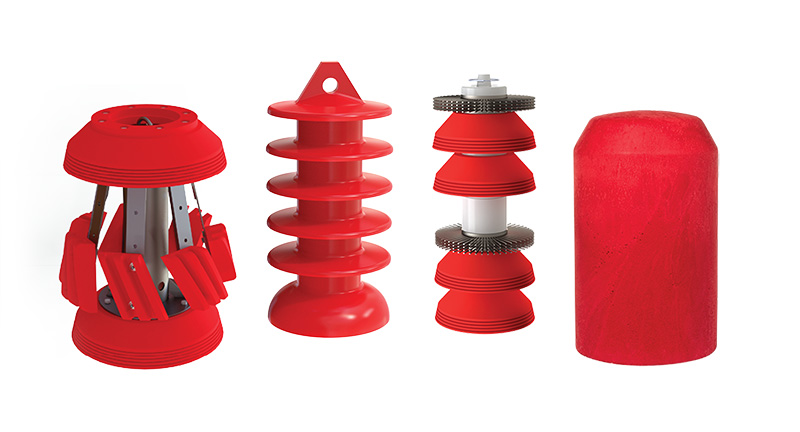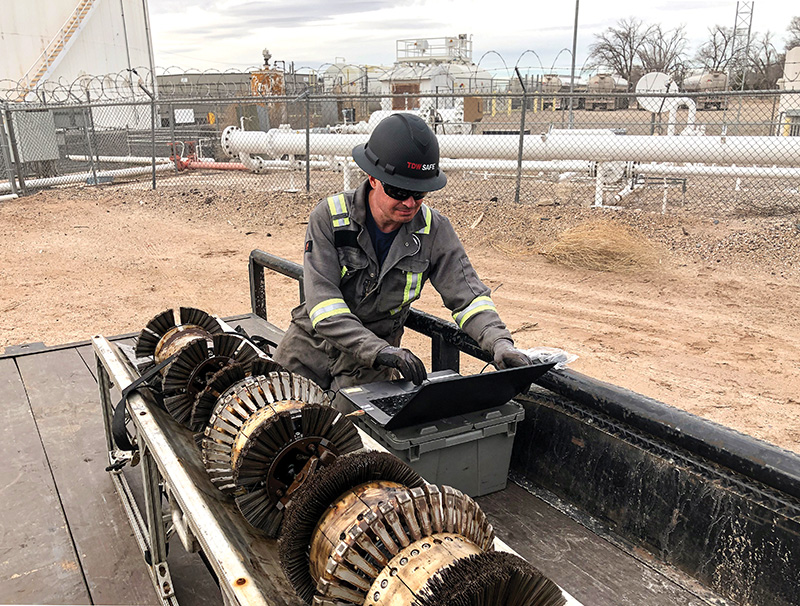October 2022, Vol. 249, No. 10
Features
Hydrogen Takeoff, Grounded in Safe Pigging Operations
By Neil McKnight, Senior Business Development Manager, T.D. Williamson, UK
(P&GJ) — As a critical medium for storing and transporting large volumes of renewably produced energy over long distances, hydrogen is expected to help fuel the drive to net-zero emissions. According to the International Energy Agency (IEA), over the next 25 years, hydrogen demand is expected to grow six-fold from today’s levels.
In its 2021 World Energy Transitions Outlook, the International Renewable Energy Agency (IRENA) estimates that by 2050, hydrogen and its derivatives will account for 12% of final energy consumption.2
To fulfill its promise, though, hydrogen’s takeoff must be grounded in safety. The fact is, hydrogen poses unique embrittlement and corrosion risks to steel pipeline and to energy infrastructure and equipment, and that’s true whether it’s being transported with methane or in its pure form. In 2004, a report by the European Industrial Gases Association (EIGA) listed a number of hazards related to hydrogen, including it being highly flammable, easily ignited and “one of the most difficult gases to prevent from leaking.”3
What’s more, the potential of hydrogen to autoignite, whether from leaks or atmospheric vents, combined with how difficult it is to see the flame, exacerbates the hazards to operational teams working in the field. That includes technicians performing pig launching and receiving activities – the most safety-critical aspect of any pigging operation, particularly in gas lines. The action of opening the closure door is the point at which potentially explosive atmospheres can be created, and field personnel can be exposed to sudden pressure releases and projectiles.
Pigging is, of course, essential to optimizing the useful life span of any pipeline system and preventing integrity failures. The industry is working to advance pig design and material selection to ensure necessary operations can continue in the presence of hydrogen.
Purposes of Pigging
Currently, plans are underway to create new hydrogen transportation networks in many regions of the world. For example, industry association European Hydrogen Backbone (EHB) has forecasted building a 17,000-mile (28,000-km) hydrogen transportation network by 2030, which would expand to 33,000 miles (53,000 km) across 28 European countries by 2040.

For a number of reasons, at present, it is not pragmatic or feasible to do all of this with new pipelines. The reality is that repurposing existing natural gas pipelines for hydrogen service will become a significant part of a burgeoning hydrogen network. In the example of the network described in the EHB report, only 40% of the pipelines will be new — meaning, the majority will be repurposed.4
Preparing either a repurposed or new pipeline for hydrogen service requires a multifaceted pigging approach. Before an existing pipeline can be approved to transport hydrogen, it must first be inspected to identify and evaluate integrity threats for mitigation.
The European Industrial Gases Association (EIGA) suggests inline inspection (ILI) of requalified existing pipelines for hydrogen service when:
- Cathodic protection records are missing or show protection as inadequate.
- Service history or material data reports are missing.
- They have carried fluids such as crude oil or wet natural gas.
In-line inspection (ILI) of new or repurposed hydrogen pipelines can be done with tools including multidataset (MDS) technology.
Pre-cleaning before ILI ensures the inspection tools will travel safely through the pipeline. Pre-cleaning also prevents tool sensor lift-off or damage, optimizing data acquisition. Because a repurposed pipeline may already have active corrosion or be contaminated with debris and flow-restricting deposits – and because the properties of hydrogen make cleaning and drying requirements more stringent – it may take a more involved cleaning program to prepare for hydrogen transport.
Even pipelines constructed specifically for hydrogen service will still require pre-commissioning pigging. Pigs will sweep out mill scale, debris and construction materials before baseline ILI surveys are completed.
Just a Spark
Hydrogen’s volatile nature is one of the key challenges during the pig launching and retrieval process. It doesn’t take much to make hydrogen combust — just a simple spark or increased heat can do the trick.
When compared to methane, hydrogen will support combustion in the presence of air at a much wider range of concentrations (4% to 75% compared with 5% to 17% for methane). This provides a greater window of opportunity for volatile atmospheres to be present when pigging tools are retrieved.
Fortunately, there are ways to keep hydrogen’s risks in check during pigging. They rely largely on four things:
- Worksite design
- Equipment
- Robust procedures
- Competent personnel
Operational Requirements
Current comprehensive hydrogen standards don’t stipulate requirements for pigging station design and layout. However, it’s good practice to use some of the same guidance that applies to metering stations and other equipment that bring personnel into proximity with the hydrogen pipeline.
For example, EIGA says it’s preferable to locate metering stations (and, by extension, pigging stations) outdoors and to ensure that natural ventilation is “well-provided.” EIGA also suggests that if the station is enclosed, there should be safe access and egress, ventilation systems, atmospheric monitoring and electrical designs appropriate for hazardous locations.
ASME B31.12 more specifically refers to “normal practice being to provide ventilation rates high enough to dilute hydrogen leaks of 25% of the lower flammability limit (LFL), i.e., about 1% by volume air.”[3]
In addition to these precautions, it’s important to have adequate space around the launcher and receiver. That’s for both safety and operational reasons. After all, inspection tools can measure several yards, which means the barrel in front of the closure must be long enough to allow manual or mechanically assisted insertion and retrieval.
Because pigging operations can take place year-round at any time of day, it’s important to have lighting installed at the site so work can continue safely at all hours. Lighting must conform with code requirements for a hazardous electrical area.
Given hydrogen’s flammability and its tendency to autoignite, good worksite design will include efforts to prevent spark potential. However, the elimination of spark sources alone is insufficient. High ambient temperatures can heat surfaces, and proximity to heat-generating processes can increase the chance of autoignition. All equipment permanently or temporarily installed at the pigging station will need appropriate grounding.
Signage prohibiting smoking, open flames or spark-inducing equipment must be clear and prominently displayed.
Suitable Equipment
Whether the pig launchers and receivers are permanent or temporary, they commonly operate with a single valve to isolate them from the main pipeline.
Unfortunately, there have been incidents with natural gas pipelines where bypassing valves have prevented traps from being fully isolated. In one example, undetected pressure was allowed to build in front of loaded pigs in the trap. This resulted in the pigs ejecting backward and striking the personnel carrying out the launching operation.
Following ASME B31.12 requirements for valve and connection compatibility can help mitigate this risk, as well as leak testing and confirming that valves, connections and joints are fit-for-purpose before hydrogen is introduced.
While there is no specific requirement in ASME B31.12 for double isolation or other secondary measures for pigging operations, they are necessary to prevent air mixtures during gas or electric welding or cutting with torches during construction activities. This highlights the need to be sure isolations are holding.
Receiving, Purging
A mistake as seemingly simple as opening and closing valves in the incorrect sequence can create a significant threat to assets and personnel. That’s one reason ASME and EIGA both require detailed instructions and systems for employees operating or maintaining pipeline networks that carry or store hydrogen.
One area of particular concern during launching and receiving is the possibility of volatile gas mixtures forming at the closure. This can happen because of the difference in densities between the transported hydrogen or hydrogen-methane mix and the air. Hydrogen is the lightest element, and the heavier air will freely sink into quiescent chambers. As this happens, the explosive limits will change quickly, allowing volatile gases to form.
Planning appropriate purging pathways to safely remove the hydrogen or hydrogen mix from the work area is essential. For both permanent and temporary pigging stations, purging should be done through longer pipe sections away from the pig barrel.
Launchers and receivers should be inerted with nitrogen. It’s important to remember, though, that the use of nitrogen carries its own risks, including large volumes having the potential for anoxia or asphyxiation.
Using over-pressurization protection is a must in case appropriate venting pathways are shut or not available. In one catastrophic incident, when the nitrogen pump quickly exceeded the launcher’s maximum pressure rating, the lack of pressure relief valves contributed to a critical failure and fatalities.
Flaring or recompression of purged gases is the preferred solution, but there are risks associated here, too, if the procedure is not appropriately designed and managed. Given the relative gas densities, if positive pressure and flow are not sustained in the purge, it’s possible that air will sink into the flare and piping.
This can create an explosive mixture that, upon detonation, will damage the flare and its piping and send active flames backward into the launcher or receiver to ignite gases in the vessel.
Pigging operations can be complex. Often, personnel from many different companies are working on-site at the same time, and poor controls, lack of planning or miscommunication can increase the likelihood of an incident.
Reducing risk requires buy-in from all parties. That starts with training to ensure everyone understands and can recognize the hazards of working around hydrogen. Having work permit systems in place will reduce the potential for simultaneous or adjacent activities impacting overall site safety. In the event of an incident, rehearsed contingency plans and on-site resources will facilitate response.
Risks from Inside
There’s no question that engineering controls and operational planning can reduce risks. However, there are often conditions inside the pipeline that can complicate the pig receiving process.
As part of that process, the technician will verify depressurization before opening the closure. But if debris from cleaning is brought into the receiver with the pig and keeps the tool from fully passing into the oversized barrel, it can create the potential for undetected pressure in the receiver.
If pressure gauges are not suitably positioned or pressure warning devices are blocked with debris, the closure may be opened under the false impression that it is safe to do so – with potentially catastrophic outcomes.
What’s more, “black powder” corrosion byproducts such as iron oxides and irons sulfates that may be present in repurposed or blended hydrogen-methane pipelines can autoignite (pyrophoric) in the presence of oxygen. Mitigation measures include verified and monitored inerting of all zones of the vessel, the correct positioning of pressure gauges and the use of pig signalers.
It’s also important to note that low density hydrogen can make it more difficult to control the velocity of pigs in the pipeline, with speed excursions being more pronounced than in a higher density gas such as methane. Ensuring a successful run requires specialist operating knowledge.
Future Is Here
The pipeline industry has responded to the emergence of hydrogen with a surge in innovation, including defining requirements for pipeline networks that can deliver hydrogen. Yet, equipment is just part of the new hydrogen equation. In the coming years, more field operators and contractors will be working in the presence of hydrogen. Their safety is paramount.
It will take knowledge sharing, collaboration and vigilance to ensure the successful transition to hydrogen while protecting people, assets, communities and the environment during pig launching and receiving. That must start today.
Author: Neil McKnight is the senior business development manager for Integrated Pigging Solutions in the Eastern Hemisphere. He joined T.D. Williamson is 2011 and has worked in the international oil and gas services industry for more than 18 years, including in quality assurance, operations, project management, sales and commercial management in the U.K, U.S. and North Africa. McKnight earned a master’s degree in international relations from the University of Aberdeen.
References:
1 https://www.iea.org/reports/global-hydrogen-review-2021/executive-summary
2 https://irena.org/publications/2021/Jun/-/media/D491BFC62BC7462A898D7837A669DC4D.ashx
3 https://www.eiga.eu/uploads/documents/DOC121.pdf
4 https://www.argusmedia.com/en/news/2204950-european-gas-operators-expand-hydrogen-plan






Comments